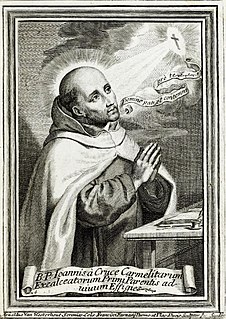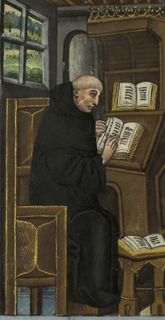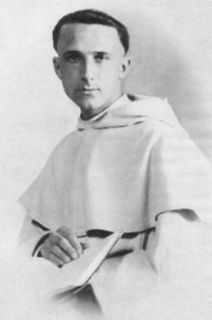Further reading
- Ayelet Even-Ezra, Ecstasy in the Classroom: Trance, Self and the Academic Profession in Medieval Paris (Fordham University Press: NY, 2018).
Guerric of Saint-Quentin (Latin Guerricus de Sancto Quintino or Guerricus Flandrensis) was a Dominican friar, theologian and teacher at the University of Paris from 1233/5 until 1242. He wrote several works on biblical exegesis and theology. [1] Along with Alexander of Hales, he is often credited with inventing the genre of the quodlibeta. [2]
Guerric entered the Dominican order around 1225. References in his commentary on Isaiah suggest that he had earlier received training in medicine. His first posting as a Dominican was a lectorship at the Basilica of San Domenico in Bologna. Sometime between 1233 and 1235 he became master of theology at the Dominican Collège de Saint-Jacques attached to the University of Paris. Among his colleagues were Hugh of Saint-Cher and Geoffrey of Bléneau; among his probable students, Albert the Great. He died between 1243 and 1245. [3]
Guerric's major works are his biblical commentaries. Besides Isaiah, he wrote commentaries on Job , Proverbs , Ecclesiastes , Song of Songs , Sirach , Wisdom , Ezekiel , Luke , John , Acts , all twelve Minor Prophets and all of the traditional Pauline epistles. All these have survived, but none have been critically edited or published. Guerric held closely to a literal interpretation. [3]
Besides his exegetical works, he also wrote one of the earliest quodlibeta, Quaestiones de quolibet, which has been edited and published, and also a commentary on Peter Lombard's Sentences . His thinking was more influenced by Aristotelianism than his contemporaries. [3]

Albertus Magnus, also known as Saint Albert the Great or Albert of Cologne, was a German Dominican friar, philosopher, scientist, and bishop. Later canonised as a Catholic saint, he was known during his lifetime as Doctor universalis and Doctor expertus and, late in his life, the sobriquet Magnus was appended to his name. Scholars such as James A. Weisheipl and Joachim R. Söder have referred to him as the greatest German philosopher and theologian of the Middle Ages. The Catholic Church distinguishes him as one of the 37 Doctors of the Church.

John of the Cross, venerated as Saint John of the Cross, was a Spanish Catholic priest, mystic, and a Carmelite friar of converso origin. He is a major figure of the Counter-Reformation in Spain, and he is one of the thirty-seven Doctors of the Church.

Abraham ben Meir Ibn Ezra was one of the most distinguished Jewish biblical commentators and philosophers of the Middle Ages. He was born in Tudela, Taifa of Zaragoza and present-day Navarre.

Giles of Rome O.S.A., was a Medieval philosopher and Scholastic theologian and a friar of the Order of St Augustine, who was also appointed to the positions of Prior General of his Order and as Archbishop of Bourges. He is famed as being a logician, producing a commentary on the Organon by Aristotle, and for his authorship of two important works, De Ecclesiastica Potestate, a major text of early 14th century Papalism, and De regimine principum, a guide book for Christian temporal leadership. Giles was styled Doctor Fundatissimus by Pope Benedict XIV.

Thomas Cajetan, also known as Gaetanus, commonly Tommaso de Vio or Thomas de Vio, was an Italian philosopher, theologian, cardinal and the Master of the Order of Preachers 1508 to 1518. He was a leading theologian of his day who is now best known as the spokesman for Catholic opposition to the teachings of Martin Luther and the Protestant Reformation while he was the Pope's Legate in Augsburg, and among Catholics for his extensive commentary on the Summa Theologica of Thomas Aquinas.

Hugh of Saint-Cher, O.P. was a French Dominican friar who became a cardinal and noted biblical commentator.

Nicholas Trivet was an English Anglo-Norman chronicler.

Adso of Montier-en-Der was abbot of the Benedictine monastery of Montier-en-Der in France, and died on a pilgrimage to Jerusalem. Biographical information on Adso comes mainly from one single source and has come under question, but the traditional biography depicts him as an abbot who enacted important monastic reform, as a scholar, and as a writer of five hagiographies. His best-known work was a biography of Antichrist, titled "De ortu et tempore Antichristi", which combined exegetical and Sibylline lore. This letter became one of the best-known medieval descriptions of Antichrist, copied many times and of great influence on all later apocalyptic tradition, in part because, rather than as an exegesis of apocalyptic texts, he chose to describe Antichrist in the style of a hagiography.
Jacobus Pamelius was a Flemish theologian who was named bishop of Saint-Omer.
Durandus of Saint-Pourçain was a French Dominican, philosopher, theologian, and bishop.

William of Saint-Thierry was a twelfth-century Benedictine, theologian and mystic from Liège who became abbot of Saint-Thierry in France, and later joined the Cistercian Order.

Réginald Marie Garrigou-Lagrange was a French Catholic theologian and Dominican friar. He has been noted as a leading neo-Thomist of the 20th century, along with Édouard Hugon and Martin Grabmann. He taught at the Dominican Pontifical University of St. Thomas Aquinas, the Angelicum, in Rome from 1909 to 1960. There he wrote his magnum opus, The Three Ages of the Interior Life in 1938.
John of Paris, also called Jean Quidort and Johannes de Soardis, was a French philosopher, theologian, and Dominican friar.

Thomas Gallus of Vercelli, sometimes in early twentieth century texts called Thomas of St Victor, Thomas of Vercelli or Thomas Vercellensis, was a French theologian, a member of the School of St Victor. He is known for his commentaries on Pseudo-Dionysius and his ideas on affective theology. His elaborate mystical schemata influenced Bonaventure and The Cloud of Unknowing.
Bartolomeo Spina was an Italian Dominican theologian and scholastic philosopher.
William of Luxi, O.P., also Guillelmus de Luxi or, was born in the region of Burgundy, France, sometime during the first quarter of the thirteenth century. He was a Dominican friar who became regent master of Theology at the University of Paris and a noted biblical exegete and preacher.
James of Lausanne was the superior of the Dominican order in France from 1318 until his death in 1321.
Peter of Atarrabia, also called Peter of Navarre, was a Franciscan administrator and theologian.